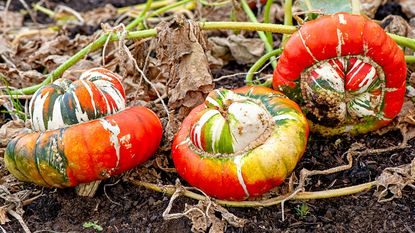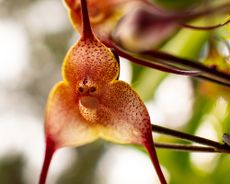Growing Heirloom Winter Squash: Turk's Turban Info


(Author of The Bulb-o-licious Garden) Varieties of squash have been grown since ancient times, with earliest types being much smaller and far more bitter than what we know today. It's for this reason that they were often cultivated more for their ornamental value than anything else. Of these old-time plants is Turk's Turban. While still grown mostly for its ornamental interest, some people also add the squash to soups. I prefer looking at it myself.
History of Turk's Turban
Squash, along with beans and corn, have a long history, with remnants of these plants dating back thousands of years - most notably in the three sisters garden. Winter squash, in spite of its name, is actually a warm-weather crop. So why then is it called winter squash? Because they all develop hard, thick rinds that allow you to store them for longer periods, typically throughout the winter. Summer types have thin skins, which can be damaged easily, and must be used right away, or upon picking in summer (unless it's frozen or canned, of course). Between these two squash types, there are four groups cultivated. Turk's Turban is a winter squash type and belongs to the Cucurbita maxima group. This heirloom squash variety can get fairly big, up to a foot across. Once mature, the colorful, fruits become bright orange and are topped with an orange-red colored protuberance, or acorn, on the blossom end which is striped with cream and olive-green. While this button-like top is called an acorn, it is not the same thing as Acorn squash, another more common squash variety. Confused yet? It also resembles a 'turban' wrapped around its top. I guess you have figured by now the reason for its name. Other names for this plant include French Turban and Turban. It was developed in France prior to 1818 but introduced to the United States sometime in the early nineteenth century, presumably around 1820, though some sources say 1869. Because of its fancy appearance, this heirloom makes a striking addition to fall garden displays.
Growing Heirloom Winter Squash
Turban squash, like most any squash, is easy to grow. Being heat lovers, they are best started indoors 3-4 weeks before the last frost, or you can direct sow once both the soil and outdoor temps have significantly warmed. Sow seed 1-2 inches deep, and transplant out when it's suitable in your area. This variety normally takes about 80-100 days to harvest. If you take care not to damage the 'turban' when harvesting, the squash can be kept in storage for long periods, sometimes up to 6 months.
Gardening tips, videos, info and more delivered right to your inbox!
Sign up for the Gardening Know How newsletter today and receive a free download of our most popular eBook "How to Grow Delicious Tomatoes."

Nikki Tilley has been gardening for nearly three decades. The former Senior Editor and Archivist of Gardening Know How, Nikki has also authored six gardening books.
-
 How To Get Rid Of Mosquitoes In The Garden: 9 Natural Ways To Make Them Buzz Off!
How To Get Rid Of Mosquitoes In The Garden: 9 Natural Ways To Make Them Buzz Off!How to get rid of mosquitoes is on the minds of people in the summer in almost every region of the world. Learn how to repel the pests without toxic chemicals.
By Mary Ellen Ellis
-
 Monkey Orchid Care: How To Grow This Fascinating Species
Monkey Orchid Care: How To Grow This Fascinating SpeciesThe monkey orchid (Dracula simia) bears a remarkable resemblance to its namesake and, with a little know-how, can be successfully grown as a houseplant.
By Bonnie L. Grant